Por favor, use este identificador para citar o enlazar a este item:
http://hdl.handle.net/10261/214140COMPARTIR / EXPORTAR:
 SHARE SHARE
 CORE
BASE CORE
BASE
|
|
| Visualizar otros formatos: MARC | Dublin Core | RDF | ORE | MODS | METS | DIDL | DATACITE | |

| Título: | Phage lysins for fighting bacterial respiratory infections: a new generation of antimicrobials |
Autor: | Vázquez, Roberto CSIC ORCID ; García, Ernesto CSIC ORCID ; García, Pedro CSIC ORCID | Palabras clave: | Phage lysins Pneumonia Respiratory infection Antibacterials Antibiotic resistance Endolysins |
Fecha de publicación: | 16-oct-2018 | Editor: | Frontiers Media | Citación: | Frontiers in Immunolgy 9: 2252 (2018) | Resumen: | Lower respiratory tract infections and tuberculosis are responsible for the death of about 4.5 million people each year and are the main causes of mortality in children under 5 years of age. Streptococcus pneumoniae is the most common bacterial pathogen associated with severe pneumonia, although other Gram-positive and Gram-negative bacteria are involved in respiratory infections as well. The ability of these pathogens to persist and produce infection under the appropriate conditions is also associated with their capacity to form biofilms in the respiratory mucous membranes. Adding to the difficulty of treating biofilm-forming bacteria with antibiotics, many of these strains are becoming multidrug resistant, and thus the alternative therapeutics available for combating this kind of infections are rapidly depleting. Given these concerns, it is urgent to consider other unconventional strategies and, in this regard, phage lysins represent an attractive resource to circumvent some of the current issues in infection treatment. When added exogenously, lysins break specific bonds of the peptidoglycan and have potent bactericidal effects against susceptible bacteria. These enzymes possess interesting features, including that they do not trigger an adverse immune response and raise of resistance is very unlikely. Although Gram-negative bacteria had been considered refractory to these compounds, strategies to overcome this drawback have been developed recently. In this review we describe the most relevant in vitro and in vivo results obtained to date with lysins against bacterial respiratory pathogens. | Descripción: | 12 p.-2 tab. | Versión del editor: | https://doi.org/10.3389/fimmu.2018.02252 | URI: | http://hdl.handle.net/10261/214140 | DOI: | 10.3389/fimmu.2018.02252 | E-ISSN: | 1664-3224 |
| Aparece en las colecciones: | (CIB) Artículos |
Ficheros en este ítem:
| Fichero | Descripción | Tamaño | Formato | |
|---|---|---|---|---|
| fimmu_García, P._2018.pdf | Artículo principal | 244,89 kB | Adobe PDF |  Visualizar/Abrir |
CORE Recommender
PubMed Central
Citations
53
checked on 04-abr-2024
SCOPUSTM
Citations
78
checked on 19-abr-2024
WEB OF SCIENCETM
Citations
71
checked on 25-feb-2024
Page view(s)
168
checked on 23-abr-2024
Download(s)
81
checked on 23-abr-2024

